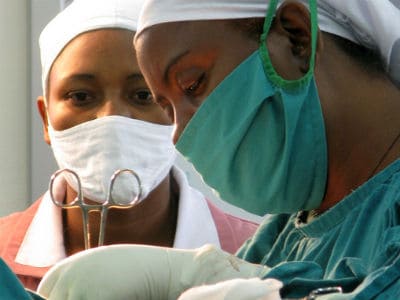
Fistulas: Top five facts
Fistulas usually result from complications while giving birth. Teen moms and those with female genital cutting (FGC) are particularly susceptible.
What are fistulas?
A fistula is a hole between the vagina and either the bladder or anus. Fistulas lead to incontinence and other medical and social consequences.
Fistulas often result from complications that extend the time it takes giving birth. For example, fistulas can happen with teenagers whose pelvic structures are not yet properly formed. Or they happen because the baby cannot fit through an overly-tight vaginal opening. This is often the case with women who have undergone types three or four of female genital cutting (FGC) that involves sewing up the vagina. So when women encounter problems while giving birth and there’s no medical help, a hole can form.Two million women
In general, fistulas are a problem in regions where women in labour lack speedy access to medical help. Worldwide, there are over two million women with fistulas, according to the World Health Organisation. Three-quarters live in Africa, with half of the world’s cases living in Nigeria. But it’s difficult to get reliable statistics since women with fistulas often suffer in silence and are isolated from their communities.
Because in these cases the labour process takes too long, babies are often stillborn due to a lack of oxygen.Leaking urine
Because the fistulas are holes between the vagina and bladder or anus, women with fistulas are incontinent and constantly leak urine or stool. The smell makes people deem them as unclean. Families push away their daughters or husbands reject their wives, resulting in the women becoming social outcasts.
Other medical problems are severe dehydration and malnutrition because the women stop eating and drinking to avoid producing waste. Stones and burns can form in the bladder from the high acidity in the urine. Some women also have difficulty walking from nerve damage in their legs caused by pressure from the baby’s head during the overly long labour process.Prevention
Fistulas are very easy to prevent if there is easy access to medical help. But first, girls and young women need access to birth control to prevent them from getting pregnant before their bodies are formed enough to deal with the stress of pregnancy and labour. Girls in their teens are five times more likely to suffer from a fistula than women in their 20s. If a young woman does get pregnant, they should give birth with the assistance of a health worker or other medical professional.
Women who have undergone FGC can have their cut reversed before they have their babies, to open up the vagina enough to allow the baby to pass through without complications. Unfortunately, these preventative measures are restricted by cultural beliefs.Surgery
Fistulas can easily be fixed with medical help. About 90 per cent of cases can be dealt with via surgery that closes the fistula. After they have healed, women must then exercise to strengthen their pelvic floor muscles which helps them get continent again.
Since there’s a small chance that the leaking and incontinence continues, additional surgery may be required. Many NGOs, such as Doctors without Borders, offer free medical help for women with fistulas. Unfortunately, many women don’t know about these possibilities.Have you had a fistula treated? Please share your experiences. Leave a comment below or join the discussion on Facebook.
